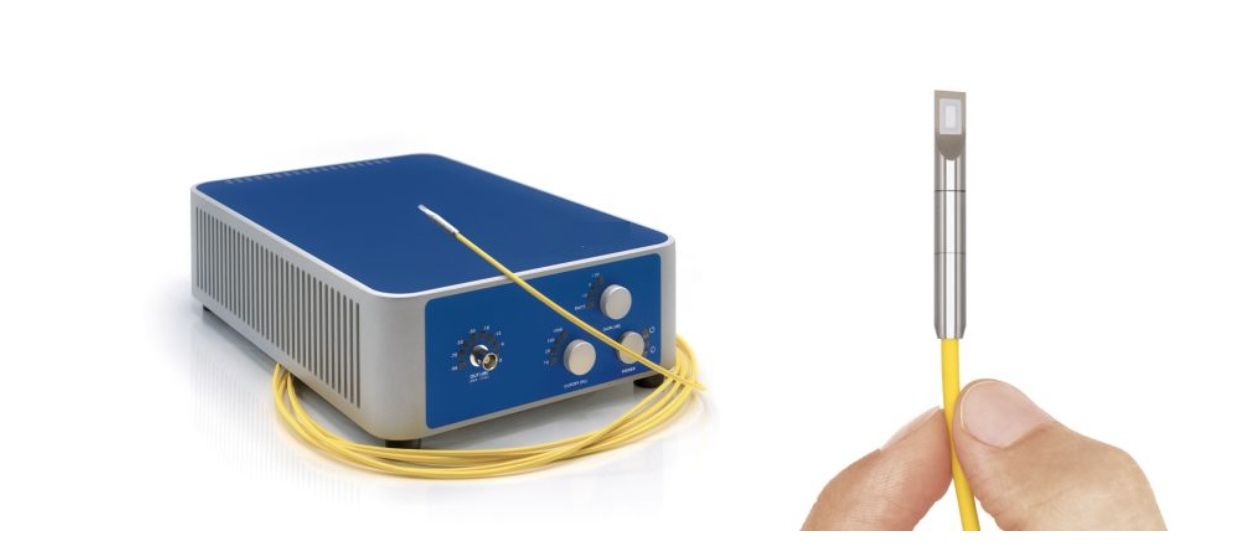Laser Microphone

This is a rugged, diaphragm-free, broadband microphone designed for acoustic applications in gases in the mPa-to-Pa range. The frequency response extends into the MHz range.
In addition to pure acoustic measurement, it is particularly suitable for measurements in process control and non-destructive material testing. Every process has its typical noises, which go far beyond our audible frequency range. For example, the filling of a small vial in the pharmaceutical sector generates typical noises when a certain filling level is reached.
Everybody knows the effect when a wine glass has a small crack that the sound of the glass sounds duller when bumped than without a crack. In the same way, you can excite a workpiece or a weld seam with a laser pulse and then listen to the typical sounds.
In addition to the actual laser microphone, we also offer peripherals such as a data acquisition system and analysis software on request. With the help of the patented technology, the sensor is almost immune to damage caused by high-pressure amplitudes. The acoustic detection is 10 times larger than the current state of the art. It offers an unprecedented superior measurement bandwidth.
Technology
For the detection of sound waves, conventional microphones use membranes or other moving parts as intermediaries between the incoming acoustic and the resulting electrical quantity. For acoustic ultrasound sensors based on piezoelectric crystals, the approach is similar: the acoustic wave mechanically deforms the crystal. In contrast, the patented idea behind the Laser Hydrophone is to exploit another, completely different property of sound: The fact that sound changes the speed of light!
In a rigid Fabry-Pérot laser interferometer consisting of two miniaturized mirrors, sound pressure changes the refractive index of the water. This alters the optical wavelength and the light transmission which consequently leads to the respective electrical signal. In contrast to conventional hydrophones, the Laser Hydrophone is the world's first system without any moving parts. No mechanically movable or physically deformable parts are involved. By consequence, the sensors exhibit a compelling frequency bandwidth, free from mechanical resonances. The sensor principle is highly sensitive. In fact, refractive index changes below 10-14 can be detected with this technology. This corresponds to pressure changes as small as 1 μPa.
Four different versions with different sensitivities are available.
Applications
Our solutions are used in non-destructive battery testing, process control, semiconductor testing and composite materials.
They also deliver precise and reproducible results in microelectronic inspection and spot weld inspection – for maximum quality and process reliability in research, development and production:
- Inspection of Composite Materials [PDF, 467 KB]
- Laser Microphone [PDF, 306 KB]
- Microelectronic Inspection [PDF, 512 KB]
- Non-Destructive Battery Inspection [PDF, 427 KB]
- Process Monitoring [PDF, 386 KB]
- Spot Weld Inspection [PDF, 307 KB]
- Ultrasound Measurement [PDF, 339 KB]
Technical Data
| Microphone: | fiber-coupled laser microphone |
| Measuring method: | membrane-free, optical, contact-free |
| Electromagnetic interference (EMI): | none |
| Effective aperture: | 60 μm x 1.2 mm, defined by laser beam |
| Application media: | gas |
| Frequency range: | 10 Hz - 1 MHz |
| Max. Pressure amplitude / Frequency of different versions: | Sensitive: 1200 Pa, 10 Hz – 1 MHzHigh sensitive: 400 Pa, 10 Hz – 1 MHzUltra high sensitive: 40 Pa, 50 kHz – 2 MHzHyper sensitive: 20 Pa, 50 kHz – 4 MHz |
| Self-noise, BW 1 Hz at 100 kHz: | 50 μPa (1 kHz) or less |
| Self noise level: | 50 mPa over the entire bandwidth or less |
| Max. sound pressure for THD <3%: | 400 Pa |
| Max. sound pressure level f. THD <3%: | 146 dB rel 20 μPa |
| Damage threshold: | >194 dB rel 20 μPa |
| Sensitivity: | 10 mV/Pa (1kHz, 50 Ohm) |
| Directional sensitivity: | omnidirectional |
| Calibration: | calibrated |
| Size of the sensor head: | diameter: 5 mm; length: 38 mm |
| Weight of sensor head: | 10 g |
| Fiber cable length: | 5 m (others on request, max. 150 m) |
| Operating temperature sensor: | -20°C to 100°C (0 F to 210 F) |
| LASER CONTROL UNIT: | |
| Sensor Output voltage: | ± 15 V (high impedance), ± 7.5 V (50 Ohm) |
| Sensor output connection: | BNC |
| Sensor output impedance: | 50 Ohm |
| Size of control unit: | 220 mm x 330 mm; Height: 95 mm |
| Weight of control unit: | 8 kg |
| Power supply (signal conditioning): | 120/230 V ± 5%, 50/60 Hz |
| Power consumption: | <50 W |
| Operating temperature of control unit: | 15°C to 30°C (60 F to 85 F) |
| Other sensitivities for higher or lower sound levels in gas or liquids on request. |